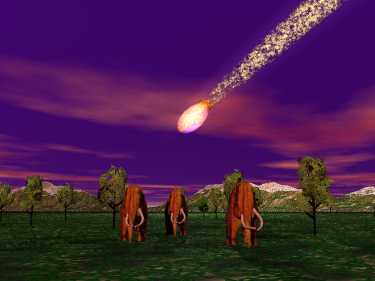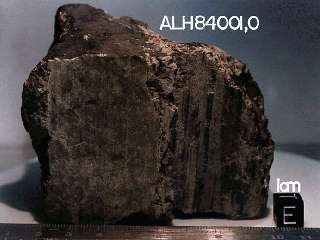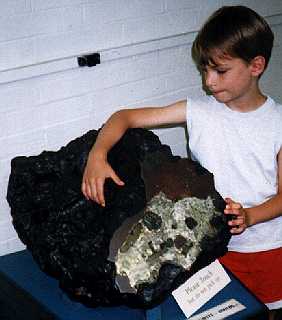pop up description layer
HOME
Cryptozoology UFO Mysteries Aviation Space & Time Dinosaurs Geology Archaeology Exploration 7 Wonders Surprising Science Troubled History Library Laboratory Attic Theater Store Index/Site Map Cyclorama
Search the Site: |
|
The Impossible Rocks that Fell from the Sky
I would more easily believe that two Yankee professors would lie than that stones would fall from heaven - Supposedly said by Thomas Jefferson after hearing of meteorite exploding over Weston, Connecticut on December 14, 1807. Science now accepts the idea that rocks can fall from outer space onto Earth. Not only does it accept the existence of meteorites, it embraces it: Major scientific theories, from the cataclysmic end of the dinosaurs to the possibility of life on Mars, turn on the existence of meteorites. This wasn't always the case, however. Until just two-hundred years ago, the best scientific minds of the era thought the idea of rocks falling from the sky was a bunch of hokum. The story of rocks falling from the sky started back in ancient times. History records that "sacred stones," probably meteorites, often became objects of worship. In the temple of Apollo at Delphi sat a sacred stone that fell to the ground from the sky. According to Greek mythology, Kronos (one of the Titans and ruler of the universe) was in the habit of swallowing his children to avoid having them growing up to overthrow him. When his son Zeus was born, Kronos' wife, seeking to save the child, tricked Kronos into swallowing a stone instead. When Zeus finally did overthrow Kronos to become King of the Gods, Kronos regurgitated the stone. It fell to Earth at Delphi. Visitors to the temple built there reported that the stone was "of no great size" and was anointed by the resident priests every day. In November of 1492, a 280-pound meteorite fell in a wheat field near the village of Ensisheim, France. A young boy witnessed it and led the townspeople to a three-foot deep crater where it lay. The people thought the object to be of supernatural origin. After seeing it King Maximilian of Germany declared that it must be a sign of the wrath of God against the French who were in a war with the Holy Roman Empire at that time. Maximilian ordered the rock to be moved to the church of Ensisheim where it could sit as a reminder of God's intervention. It stayed there until the French Revolution when the secular government seized it and moved it to a national museum at Colmar. Ten years later it was returned to the church and eventually moved to the town hall in Ensisheim where it rests today. The meteorite is now less than half of its original weight, the victim of souvenir hunters and scientists who removed samples from it for study while it lay in Colmar.
Despite these incidents, many learned people refused to believe that rocks could fall from the sky. The great Greek philosopher Aristotle thought that rocks could not fall from the sky because the heavens were perfect and could not possibly have loose pieces floating around to fall to Earth. When a meteorite fell at Thrace near Aegospotami, Aristotle was forced to take the position that strong winds had lifted an Earth rock into the sky, then dropped it.. An alternate theory was developed to explain stones that fell from the sky. This theory held that meteorites somehow formed in the sky during violent thunderstorms. Proponents of this idea suggested that particles inside the clouds consolidated because of the heat during a lighting flash. For this reason the rocks were sometimes referred to as thunderstones. Science and the scientific method began to develop around the seventeenth century. A healthy skepticism of stories that could not be proven through either independent observation or explained by known facts developed in scientists' minds. Scientists learned to put aside their personal beliefs to observe the natural world as it actually existed. While this advanced astronomy, chemistry and mathematics, the study of meteorites suffered. Why? The fall of a rock from the sky was so rare that the chances of a scientist being there in person to observe it was very small. Also, reports of rocks falling from the sky had always been associated with evil omens or stories of disaster. This made accounts of meteorite falls that came in from the countryside easy to dismiss as folklore. In 1790 a fireball raced across the sky near the town of Barbotan in southwest France. Immediately after the fireball disappeared a shower of stones fell. Over three-hundred people witnessed this event, making it difficult for French scientists to discount. The scientists were forced to admit there was some connection between the fireballs that fell from the sky and the rains of stone. In 1794, four years later, more than 200 stones fell from the sky near Siena, Italy with enough witnesses to make the existence of the event undeniable. Though many scientists explained the stones as condensations from "igneous clouds" or volcanic ash from Mount Vesuvius, a German researcher had a different idea. That year Ernst Friedrick Chladni published his theory in a book titled On the Origin of the Mass of Iron Discovered by Pallas and Others Similar to It, and on Some Natural Phenomena Related to Them. In this work Chladni built a case that rock falls were related to fireballs even if the fireballs were not observed. He also reached the conclusion that fireballs because of their very high-speeds, among other characteristics, had to be coming from outer space. At first many scientists were reluctant to accept what seemed like such an outlandish idea, but a rock fall investigated by Jean-Bapiste Biot in 1803 cinched the case. Biot showed that some thousand stones had fallen in an elliptical pattern, just the sort of pattern one might expect from a disintegrating fireball coming down at an angle.
Across the sea in the new United States, scientists that were still doubtful of Chladni's theory found themselves confronted by the Weston fireball of December 14, 1807. Two scientists from Yale College recovered 330 pounds of stony material from the path of that fireball. The rocks recovered became the first of a large collection of meteorites that is now housed at Yale University. Further proof of the celestial origin of meteorites was provided by an English chemist named Edward Charles Howard. After examining meteorite specimens recovered from widely-separated locations in Europe and Asia, he found that they fell into three categories: mostly stone, mostly iron and a mixture of both stone and iron. The most startling thing Howard discovered was that almost all meteorites had a form of nickel alloyed with the iron. Nickel is almost never found mixed in with iron deposits on Earth. Howard's analysis went a long way toward establishing that all meteorites were related to one another, but not related to the rock in the areas which they had been found. This indicated that they had all come from a single location that was not on the planet Earth. Even after scientists accepted the idea that rocks could fall out of the sky, it still took them a while to come to believe that really big rocks could fall from the sky. Rocks large enough to make craters like those seen on the moon. This was partly because the largest meteor impact witnessed was only about a ton in weight and had made a hole just slightly larger than itself. Most scientists in the beginning of the 20th century thought that very large meteors would burn up in Earth's atmosphere before they hit the ground. This changed as the result of the work of Daniel Moreau Barringer, a geologist, mining engineer and lawyer. European Americans had been aware of a mile-wide, six-hundred foot deep, dish-shaped depression with raised edges in the plain of Arizona since the 1870's. Scientists that surveyed the spot late in the 19th century knew that the area surrounding the plain was littered with chunks of meteorite, but never understood that the depression was a huge impact crater. Most reached the conclusion that this feature was the result of a volcanic steam explosion. In 1902 Barringer looked at the reports of iron meteorite debris in the area and figured that somewhere buried below the surface of the crater was a huge meteorite mass weighing hundreds of tons. Barringer obtained the mining rights to the area thinking to find the meteor and sell off the valuable iron and nickel it contained. He pursuded this dream for almost 30 years, but never found the main mass of the meteorite. However, his drilling and excavations provided evidence to astronomer F.R. Moulton who also recognized that the crater was formed by an impact of a meteorite. Moulton correctly concluded the speed of the impact of the mass was so high (7 to 17 miles a second) that the bulk of the meteorite was vaporized, leaving only small fragments in the surrounding area that had split off the main mass prior to the impact.. The load of iron and nickel Barringer had been looking for did not exist. Controversy over the origin of the crater continued until 1957 when Eugene Shoemaker, a geology graduate student, reexamined the site and produced additional evidence showing that the crater was the result of an iron meteoroid about 80 feet in diameter and weighing 63,000 tons, hitting the plain approximately 50,000 years ago. The impact released energy equivalent to a 1.7-megaton bomb. At about the same time Barringer was exploring the arizona crater, Leonid Kulik was also looking for a huge meteorite in Asia. Kulik, a Russian scientist, lead an expedition to Siberia in 1921 to investigate stories of a fireball that leveled hundreds of square miles of forest in 1908. His report further lent support to the idea that large meteorites, capable of doing major damage, occasionally hit the earth. In fact, if the Siberian meteorite had come 4 hours later, it would have destroyed the city of Moscow as effectively as a hydrogen bomb.
Science learned to accept the idea that stones- sometimes big stones - could fall from space and the notion of thunderstones was relegated to the trash can of folklore. Almost. Almost, because even in recent times reports of stones falling to the ground during heavy thunderstorms still occasionally occur as this report from the March 14, 1920 issue of Nature indicates: During a heavy thunderstorm which ensued on Monday, March 4, between 2:30 p.m. and 4.15 p.m., an aerolite was observed to fall at Conleny Heath, near St. Albans. The observed who has placed the specimen in my hands for examination, stated that the stone fell within a few feet from where he was standing, and that it entered the ground for a distance of about 3 feet. Its fall was accompanied by an unusually heavy clap of thunder. The example weighs 5 pounds 14 1/2 ounces and measures 6 3/4 inches by 5-5/8 inches at its great length and breadth respectively. The mass is irregularly ovate on the one side, and broken in outline on the other. The actual surface throughout is fairly deeply pitted, and under magnification exhibits the usual chondritic structure of the crystalline matter with interspersed particles of what appears to be nickeliferous iron. The author of the report, G.E. Bullen, submitted the stone to the British Museum where it was examined and determined not to be of meteorite origin. So do thunderstones really exist? Science once thought that meteorites were not real. Perhaps a hundred years from now we will know that they were wrong about thunderstones, too. But then again, perhaps not. Copyright Lee Krystek 2001. All Rights Reserved. |
|
Related Links |
|
|






